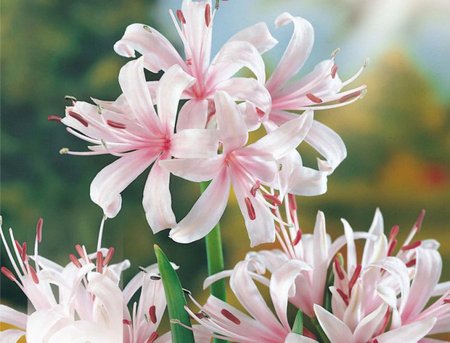There is a small select group of highly desirable bulbs for the end of the year. They provide a beautiful contrast to the more brazen shows of color on the trees and shrubs, and help keep the eye moving around the fall garden. Most require well-drained soil and plenty of sun in order to thrive, though there are some that prefer shady, moist conditions. Do not remove the foliage until it has turned brown, or next year’s display will suffer.
Canna. Commonly known as Indian shot plants, or Indian reed flowers, these are exotic plants for the fall garden. Even if they did not flower, they would be worth growing for their large, smooth leaves. Use them with grasses and brilliant dahlias to bring the season to a close with a flourish. Stictly speaking they are rhizomatous perennials, but they are planted like bulbs. They are excellent in large containers.

Cannas
The cannas grown in gardens are hybrids, of which there are many. All the following have green leaves unless otherwise indicated. All are half-hardy. ‘Black Knight’ has dark red flowers and bronze leaves. ‘Brandywine’ has scarlet red-orange flowers. ‘City of Portland’ has yellow-egded, rose pink flowers. ‘President’ has bright red flowers, ‘Orchid’ has pink flowers.
Smaller cannas can be planted together in groups, but do not overcrowd them and allow room for their leaves to develop. The taller cannas can be used as individual specimens, providing the focal point of a bright display.

Canna ‘City of Portland’
Colchicum. These pretty bulbs are often known as fall crocus, or naked boys (or naked ladies in UK). The flowers of colchicums are always a surprise when they appear, and it is easy to forget that the corms are in the garden. The leaves, large ang glossy, do not appear until the following spring. They are excellent in light woodland or planted around shrubs. Robust types are also excellent for naturalizing in grass. C. speciosum is the most widely grown member of the genus, and produces goblet-shaped, pink flowers in fall. C. ‘The Giant’ is one of many hybrids, with large, lilac-pink flowers. Plant them in light shade, for example beneath deciduous trees and on the sunny side of shrubs.

Colchicum ‘The Giant’
Cyclamen. The genus includes 19 species of tuberous perennials, found in a wide variety of habitats from the eastern Mediterranean to North Africa and the Middle East. The rounded to heart-shaped leaves often have attractive silver markings. They like well-drained, humus-rich soil in sun or partial shade. C. hederifolium is the species with pink flowers and a darker red stain towards the mouth. C. mirabile has pale pink flowers with serrated petals and purple-stained mouths. The leaves are heart-shaped and patterned with silver blotches.

Cyclamen mirabile
Sternbergia. This genus of 8 species of dwarf bulb is found on hillsides, scrub and pine forests in southern Europe, Turkey and central Asia. They are similar to crocuses but have 6, not 3, stamens and grow from bulbs rather than corms. Like the crocus, some species are fall-flowering, and some flower in spring. All parts are poisonous. They need hot sun and well-drained soil that dries out in summer. S. lutea has yellow, goblet-shaped flowers, 4 cm across, that appear at the same time as the dark green, strap-like leaves.

Sternbergia lutea
Nerine. This is a genus of about 30 species of bulbs found on well-drained mountainous sites in Africa. The common name, Guernsey lily, is properly applied to N. sarniensis. The flowers appear in the fall, followed by the leaves in late winter, and the plant goes dormant in summer, when it likes a dry, warm period. They flower best when the bulbs are packed quite close together. N. bowdenii has umbels of up to 7 or more funnel-shaped, slightly scented, pink flowers, each to 7,5 cm across, with wavy-edged, recurved petals, borne on stout stems. It must has a well-drained site and is a good choice for the foot of a sunny wall, where the pink flowers look striking. In cold areas, provide a dry mulch in winter.

Nerine sarniensis
